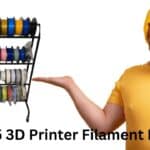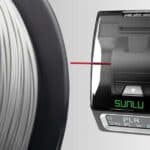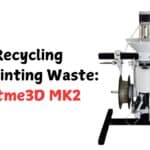
Mastering post-processing with 15 techniques—like sanding or electroplating—elevates prints for hobbyists and pros, tailored to your material and project, with safety gear a must.
3D printing unlocks endless creative possibilities, but achieving a smooth, professional finish requires mastering post-processing. Whether you’re working with FDM, SLA, or SLS prints, this guide dives into Top 15 Must-Have 3D Printing Tools for Perfect Finishes. We’ll explore subtractive, additive, and property-changing methods, complete with pro tips, safety guidelines, and material-specific recommendations. Let’s elevate your 3D printing game!
Affiliate Disclosure
We participate in Amazon affiliate programs, earning fees from qualifying purchases via links at no extra cost to you. It’s how we keep this blog rolling and my 3D printers buzzing with fresh filament for reviews like this one!
Find your perfect match—get the Elegoo Neptune 4 Pro ($359) on Amazon today!
Why Post-Processing Matters
Post-processing is critical for:
- Removing layer lines and support marks.
- Enhancing durability and aesthetics.
- Preparing models for painting or functional use.
- Reducing stress points in structural parts.
Related: Top 10 3D Printing Filaments for Industrial Use
Top 15 Must-Have 3D Printing Tools for Perfect Finishes
Subtractive Methods: Removing Material for Smoothness
1. Trimming & Cutting
What It Does
Removes support structures, strings, and blobs.
Tools Needed
- Precision knives (e.g., X-Acto Z-Series)
- Flush cutters or nippers
- Tweezers for resin prints
Pro Tips
- Use a heated knife for cleaner cuts on PLA.
- Sand connection points after trimming to avoid bumps.
2. Sanding & Polishing
What It Does
Erases layer lines and refines surfaces.
Step-by-Step
- Coarse Grit (100–220): Remove major imperfections.
- Medium Grit (400–600): Smooth uneven areas.
- Fine Grit (800–2000): Prep for priming or painting.
- Polishing: Use Novus Plastic Polish for glossy finishes.
Material Tips
- PLA: Avoid power sanders (melts easily).
- Resin: Wet-sand with 1000+ grit for mirror finishes.
3. Vapor Smoothing
Best For
ABS, ASA, and Nylon.
How It Works
Solvent vapors (e.g., acetone) melt the surface layer for a glossy finish.
Methods
- DIY Chamber: Use a glass jar with acetone-soaked paper towels.
- Professional Systems: Like Polymaker’s Polysher.
Safety
Perform in a well-ventilated area; acetone is flammable.
4. Sandblasting (Abrasive Blasting)
What It Does
Creates uniform matte finishes on metals, resins, and tough plastics.
Equipment
- Budget Option: VEVOR Portable Sandblaster ($150).
- Media: Glass beads (soft) vs. aluminum oxide (aggressive).
Ideal For
Industrial parts or models with minimal detail.
5. Tumbling
What It Does
Smooths small parts using rotational friction.
Media Options
- Ceramic cones for PLA.
- Walnut shells for delicate resins.
Use Case
Ideal for batch-processing miniatures or jewelry.
Related: 6 Top Decor Items to Illuminate Your Diwali
Additive Methods: Enhancing Surfaces with New Layers
6. Filling Gaps & Imperfections
Products to Use
- Bondo Spot Putty: Fast-drying for small cracks.
- Epoxy Resin: For structural repairs.
- Wood Filler: Sandable and affordable.
Application
Spread with a putty knife, then sand smooth.
7. Priming
Why Prime?
Creates a uniform base for paint and hides minor flaws.
Top Primers
- Rust-Oleum Filler Primer: Fills micro-layers.
- Tamiya Surface Primer (Spray): Ultra-fine finish for miniatures.
8. Coating & Sealing
Options
- Brush-On Resin: Adds waterproofing and shine.
- Spray Varnish: Protects painted surfaces from UV damage.
- Powder Coating: For metal prints; requires a curing oven.
9. Foiling & Vinyl Wrapping
Best For
Cosplay props or automotive parts.
Steps
- Clean the model with isopropyl alcohol.
- Apply heat with a hairdryer to stretch vinyl over curves.
- Trim excess with a precision blade.
10. Metal Plating & Electroplating
What It Does
Adds conductive, corrosion-resistant metal layers.
Process
- Electroless Plating: Apply copper/nickel via chemical bath.
- Electroplating: Submerge in a metal-ion solution with an electric current.
Materials
Works with ABS, PLA (after conductive coating).
Property-Changing Methods: Altering Material Structure
11. Heat Gun Melting
Use Case
Fix stringing or blend layer lines on PLA/PETG.
Tips
- Keep the gun 2–3 inches away to avoid warping.
- Use a silicone brush to gently reshape melted areas.
12. Annealing
Best For
Reducing internal stress in PLA, Nylon, or PC.
How-To
- Preheat oven to 160–200°F (lower than material’s melting point).
- Bake prints for 30–60 minutes, then cool slowly.
Result
Increased heat resistance and strength.
13. Chemical Smoothing (Beyond Acetone)
Material-Specific Solvents
- PLA: Ethyl acetate (test first!).
- PETG: MEK (methyl ethyl ketone).
- Resin: UV-resistant clear coats.
14. UV Curing for Resin Prints
Pro Tips
- Post-cure in a UV chamber for 10–15 minutes.
- Submerge in water during curing to reduce oxygen inhibition.
15. Epoxy Coating
What It Does
Adds a thick, durable shell.
Brands
- MAS Epoxies: Self-leveling for glass-like finishes.
- JB Weld: For functional parts needing impact resistance.
Safety First: Essential Gear
- Respirator Mask: For sanding, chemical fumes.
- Nitrile Gloves: When handling resins/solvents.
- Ventilation: Use fume hoods or open windows.
Related: Top Metal 3D Printers for 2025: A Comprehensive Guide
Material-Specific Cheat Sheet
| Material | Best Techniques | Avoid |
|---|---|---|
| PLA | Sanding, priming, epoxy coating | Acetone vapor |
| ABS | Vapor smoothing, electroplating | UV resin coating |
| Resin | Wet sanding, UV curing | Aggressive sandblasting |
Related: Top 5 Resin 3D Printers on Amazon in 2025
Frequently Asked Questions (FAQs)
How do I smooth 3D prints without sanding?
Use vapor smoothing (ABS) or epoxy resin coating (PLA/resin).
Can I polish resin prints to transparency?
Yes! Wet-sand up to 3000 grit, then polish with Novus #3.
What’s the fastest way to finish PLA?
Combine filler primer with light sanding (400 grit).
Conclusion
Mastering post-processing turns good prints into exceptional ones. From basic sanding to advanced electroplating, these 15 techniques cater to hobbyists and professionals alike. Experiment with methods suited to your material and project needs—and don’t forget safety gear!
Ready to level up? Share your favorite techniques in the comments.
Find your perfect match—get the Elegoo Neptune 4 Pro ($359) on Amazon today!













